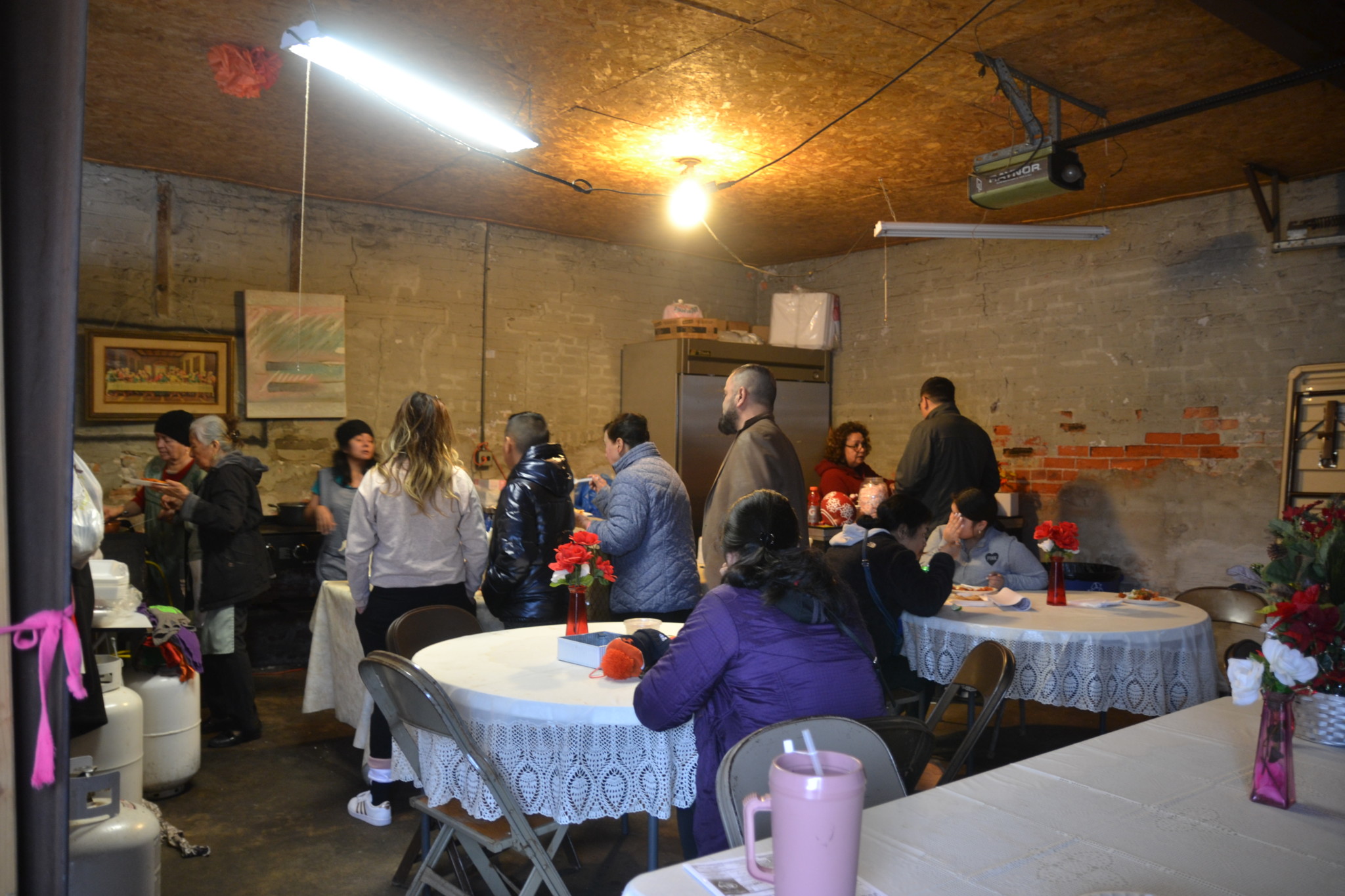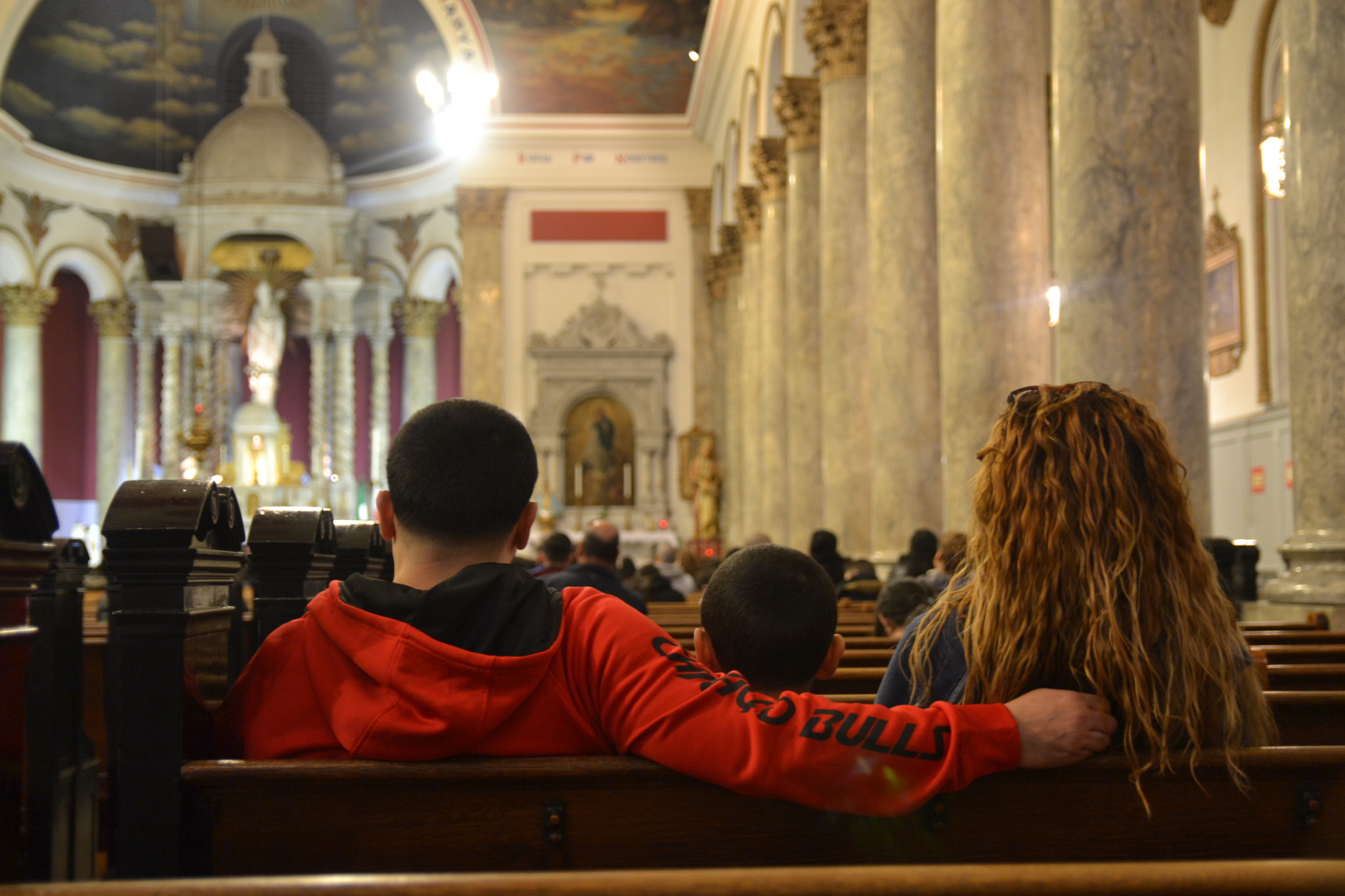It’s a few minutes after noon, and families are still trickling in through the large wooden doors of St. Adalbert Church in Pilsen. Young and old are quietly making their way through the pews. A Kimball organ, one of the largest pipe organs in the Midwest, plays its final notes from the upper floor as Father Michael Enright and Deacon Juan Dominguez begin the introductory rites for mass.
Every Sunday morning, St. Adalbert holds two Catholic masses: one in English and one in Spanish. A Polish mass is also held at the beginning of every month, a modern-day testament to St. Adalbert’s historical roots as a church built by an immigrant Polish community more than a century ago.
The church sits on 17th Street between Ashland and Paulina, and its two defining 185-foot towers are visible from the platform of the 18th Street Pink Line “L” stop. Built in 1912 by architect Henry Schlacks, St. Adalbert was modeled after St. Paul’s Basilica in Rome. The building itself is magnificent, built in the neoclassical style with stained-glass rose windows and Italian marble adorning the space throughout.
Recently, however, the the future of St. Adalbert has become uncertain. According to a listing on commercial real estate site SVN as of September 2018, the Archdiocese of Chicago is selling St. Adalbert Church. No buyer has been disclosed yet, though a number of religious and non-religious organizations have expressed interest, according to Anne Maselli, a spokeswoman for the Archdiocese.
St. Adalbert is not only a beacon of Pilsen’s Catholic heritage, it is also a reminder of Chicago history. “It’s a symbol of the neighborhood’s working-class and immigrant background,” said Alicia Torres, a parishioner at Sunday mass, “and it’s important that the symbols of that remain today.”
Since moving to the Pilsen neighborhood in 1964, Torres has attended mass at St. Adalbert almost every Sunday and has never lived more than two blocks from the church. She raised her family around St. Adalbert as well; her daughters attended school on the campus of St. Adalbert’s premises, and one was married in the basilica.
“I pray every day for this church not to close,” Torres continued, fighting back tears. “It’s like a second home to me.”
One of Alicia Torres’s daughters, Blanca Torres, has led efforts for the past few years to save the church as the Vice President of the St. Adalbert Preservation Society.
“St. Adalbert was where I grew up,” Blanca Torres reflected. “I’ve lived across the street, I’ve had this church in my life since I was a baby, and I consider it an honor and a privilege to be part of the movement to save the church.”
This is not the first time the church has been under threat of permanent closure. In 2016, St. Adalbert Parish was closed and merged with the neighboring St. Paul Parish as part of the Archdiocese’s Renew My Church initiative, an effort to consolidate parishes that were facing limited financial resources. The following October, the Archdiocese of Chicago announced the sale of the St. Adalbert church building to the Chicago Academy of Music, which would have converted the church into a music hall. The deal fell apart a few months after the announcement.
Maselli expressed, in a written statement to the Weekly on April 3, that the decision to sell St. Adalbert this time was still “consistent with the broader Renew My Church” process. When asked about why St. Adalbert in particular needed to be closed, Maselli said that it was the best outcome for the parish as a whole.
“Not unexpectedly, these reconfigurations will, in certain cases, result in different needs for worship and supporting spaces, as is the case with the St. Adalbert parish campus,” said Maselli. “The parish determined that the other existing church spaces could better support the parish’s needs going forward.”

Selling St. Adalbert would be both a cost savings and a revenue opportunity at a time when the Archdiocese is financially strapped.
“The scaffolding has been up [on the towers] for five years, and from my understanding it’s costing about $12,000 a month,” said Julie Sawicki, president of the predominantly Polish Society of St. Adalbert (SOSA). Along with regular maintenance costs, the building also needs substantial repairs. Maselli estimates that the needed repairs could “total in the millions of dollars”.
“The Archdiocese is in a financial crunch,” said Ward Miller, executive director of Preservation Chicago, partially due to recent costs associated with public relations as well as an underfunded priests’ pension fund. According to the Sun-Times, about $100 million in proceeds from a recent sale of a parking lot at Holy Name Cathedral downtown will go towards “repaying money that was borrowed to cover the financial cost of clergy sex abuse claims.”
Although it is uncertain where the potential proceeds from St. Adalbert’s sale would go, it’s clear that the real estate is highly valuable. Sawicki estimates that the land value of St. Adalbert alone could sell for around $4 to $6 million.
The battle for St. Adalbert is also reflective of a familiar narrative in Pilsen: as property values have soared, more and more developers have bought up properties, pushing out current residents in pursuit of tenants with deeper pockets.
A year ago, the Archdiocese closed down St. Ann Church, located in Pilsen a few blocks from St. Adalbert. Earlier this year, Block Club Chicago reported that the Archdiocese sold the church to a private developer for $1.35 million to convert into “residential living.”
The Archdiocese has cited declining parishioner enrollments as the primary rationale for its church closure and parish consolidation strategy in Pilsen. But Moises Moreno, a community organizer with the Pilsen Alliance, argues that the issue is broader than that.
“It’s all tied to the phenomenon of gentrification. As families move out and people get displaced or evicted, it reflects on the parish,” he said.
Rising rents have pushed out a large number of the neighborhood’s working class and Mexican-American community, many of whom constitute the parishioner base at churches like St. Adalbert and St. Ann. Studies have shown that between 2000 and 2016, Pilsen lost more than 10,000 of its Latino residents, representing a twenty-six percent decline.
Moreno cites that the Archdiocese has historically lacked genuine engagement and dialogue with the community. “They don’t really have a clear understanding of what community relations really looks like, and the impact that it has in parishes and communities of color,” he said.
In an email statement on behalf of the Archdiocese, Maselli wrote that the “Archdiocese and the parish are sensitive to the long history of St. Adalbert and its impact on the Pilsen community,” and that “input will be sought from a variety of constituents, both internally and externally.”
But unlike previous church closures, where the churches had been closed for years before the decision to sell, or the community was not as invested in saving the church, the proposed closure of St. Adalbert rallied various community groups and nonprofits to propose several potential solutions to save the church.
Blanca Torres and the St. Adalbert Preservation Society have sought help from the Vatican itself. In 2017, the group filed a parishioner appeal to oppose the church’s sale to the Chicago Academy of Music on the grounds that the Academy was a secular entity that was prohibited from owning the church under canon law of the Catholic Church.
Over the course of two years, the appeal has moved through the courts, ultimately reaching the highest judicial authority in the Catholic Church, which ruled that St. Adalbert is still a sacred site and will remain within the parish of St. Paul.
The decree is significant because it could provide support for the case against selling St. Adalbert. It means that under canon law, the Archdiocese cannot sell the property to a non-sacred, secular entity, such as a private developer, because the church is still a sacred site and must be used only for religious purposes, Torres told the Weekly.
“The fact that we were able to do the Vatican appeal did help us in remaining open as long as we did, with masses still going on,” Torres said. “I think it was a major part of why St. Adalbert is still around today.”
However, the ruling is non-binding, and there are limitations to how the decree will play into the ultimate decision from the Archdiocese, which holds the final authority over St. Adalbert as the legal owner of the property. The decree also only protects the church building itself, and not the rest of the property including the convent, rectory, and parking lot, which parishioners would like to keep together.
Another idea is to designate St. Adalbert as a Chicago Landmark, which protects historically significant buildings from demolition. Such a designation would also qualify St. Adalbert for funds from the City of Chicago Department of Planning and Development to repair the exterior of the church building, according to Miller. However, designating St. Adalbert as a Chicago Landmark would require cooperation from the Archdiocese.
Still, the significance of preserving St. Adalbert goes beyond efforts to invoke the institutional strength of canon law or landmark status. For parishioners, staff, and volunteers, keeping the spirit of St. Adalbert alive every week is a testament to the legacy of both the church and the community it serves.
“It’s a community-wide effort,” said Torres. It is the parishioners, staff, and volunteers that keep the spirit of St. Adalbert alive every week. “The committed people of St. Adalbert, those are the unsung heroes.”
Amy Qin is a contributor to the Weekly. She last wrote about a neighborhood’s effort to save a community garden in Englewood, and has previously written about St. Adalbert.

